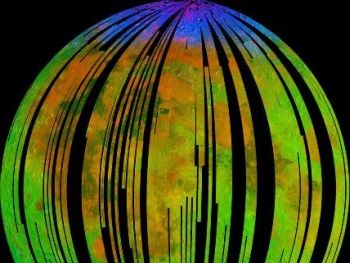
Publisher:
Bonnie King
CONTACT:
Newsroom@Salem-news.com
Advertising:
Adsales@Salem-news.com

~Truth~
~Justice~
~Peace~
TJP
Oct-08-2009 21:07

 TweetFollow @OregonNews
TweetFollow @OregonNews
NASA's LCROSS Mission Will End With A Bang...On The Moon
Salem-News.comThe Lunar CRater Observing and Sensing Satellite (LCROSS) mission is seeking a definitive answer as to whether or not there is water on the moon.
 NASA's Moon Mineralogy Mapper: Blue shows the signature of water, green shows the brightness of the surface as measured by reflected infrared radiation from the sun. Photo: NASA |
(CAPE CANAVERAL, Fla.) - Earth’s closest neighbor is holding a secret. In 1999, hints of that secret were revealed in the form of concentrated hydrogen signatures detected in permanently shadowed craters at the lunar poles by NASA’s Lunar Prospector.
These readings may be an indication of lunar water and could have far-reaching implications as humans expand exploration past low-Earth orbit.
In April 2006, NASA selected the LCROSS proposal for a low-cost, fast-track companion mission to the Lunar Reconnaissance Orbiter (LRO).
The main LCROSS mission objective is to confirm the presence or absence of water ice in a permanently shadowed crater near a lunar polar region. LCROSS launched with the Lunar Reconnaissance Orbiter (LRO) aboard an Atlas V rocket from Cape Canaveral, Fla., on June 18, 2009 at 2:32 p.m. PDT.
The LCROSS shepherding spacecraft and the Atlas V’s Centaur upper stage rocket executed a fly-by of the moon on June 23, 2009 (LCROSS lunar swingby video stream coverage) and entered into an elongated Earth orbit to position LCROSS for impact on a lunar pole. On final approach, the shepherding spacecraft and Centaur will separate.
The Centaur will act as a heavy impactor to create a debris plume that will rise above the lunar surface.
Projected impact at the lunar South Pole is currently: Oct 9, 2009 at 4:30 a.m. PDT.
Following four minutes behind, the shepherding spacecraft will fly through the debris plume, collecting and relaying data back to Earth before impacting the lunar surface and creating a second debris plume.
The debris plumes are expected to be visible from Earth- and space-based telescopes 10-to-12 inches and larger.
WATCH THE EXPLOSION: CLICK HERE
The LCROSS science payload consists of two near-infrared spectrometers, a visible light spectrometer, two mid-infrared cameras, two near-infrared cameras, a visible camera and a visible radiometer. The LCROSS instruments were selected to provide mission scientists with multiple complimentary views of the debris plume created by the Centaur impact.
As the ejecta rises above the target crater’s rim and is exposed to sunlight, any water-ice, hydrocarbons or organics will vaporize and break down into their basic components.
These components primarily will be monitored by the visible and infrared spectrometers. The near-infrared and mid-infrared cameras will determine the total amount and distribution of water in the debris plume.
The spacecraft’s visible camera will track the impact location and the behavior of the debris plume while the visible radiometer will measure the flash created by the Centaur impact.
NASA’s Ames Research Center, Moffett Field, Calif., is overseeing the development of the LCROSS mission with its spacecraft and integration partner, Northrop Grumman, Redondo Beach, Calif.
NASA says LCROSS is "a fast-paced, low-cost, mission that will leverage some existing NASA systems, commercial-off-the-shelf components, the spacecraft expertise of Northrop Grumman and experience gained during the Lunar Prospector Mission in 1999."
Ames is managing the mission, conducting mission operations, and developing the payload instruments, while Northrop Grumman designed and is building the spacecraft for this innovative mission. Ames mission scientists will spearhead the data analysis.
According to NASA, the LCROSS impact will not be noticed by the moon and only noticed by those on Earth with telescopes trained on the impact site.
"What makes the LCROSS impact special, compared to the ongoing, natural barrage, is that we control the LCROSS impact to occur at a precise place and time, allowing us to sample a specific piece of lunar real estate and be in position to monitor it."
Articles for October 7, 2009 | Articles for October 8, 2009 | Articles for October 9, 2009
Salem-News.com:



googlec507860f6901db00.html
Quick Links
DINING
Willamette UniversityGoudy Commons Cafe
Dine on the Queen
Willamette Queen Sternwheeler
MUST SEE SALEM
Oregon Capitol ToursCapitol History Gateway
Willamette River Ride
Willamette Queen Sternwheeler
Historic Home Tours:
Deepwood Museum
The Bush House
Gaiety Hollow Garden
AUCTIONS - APPRAISALS
Auction Masters & AppraisalsCONSTRUCTION SERVICES
Roofing and ContractingSheridan, Ore.
ONLINE SHOPPING
Special Occasion DressesAdvertise with Salem-News
Contact:AdSales@Salem-News.com
Terms of Service | Privacy Policy
All comments and messages are approved by people and self promotional links or unacceptable comments are denied.
[Return to Top]
©2025 Salem-News.com. All opinions expressed in this article are those of the author and do not necessarily reflect those of Salem-News.com.